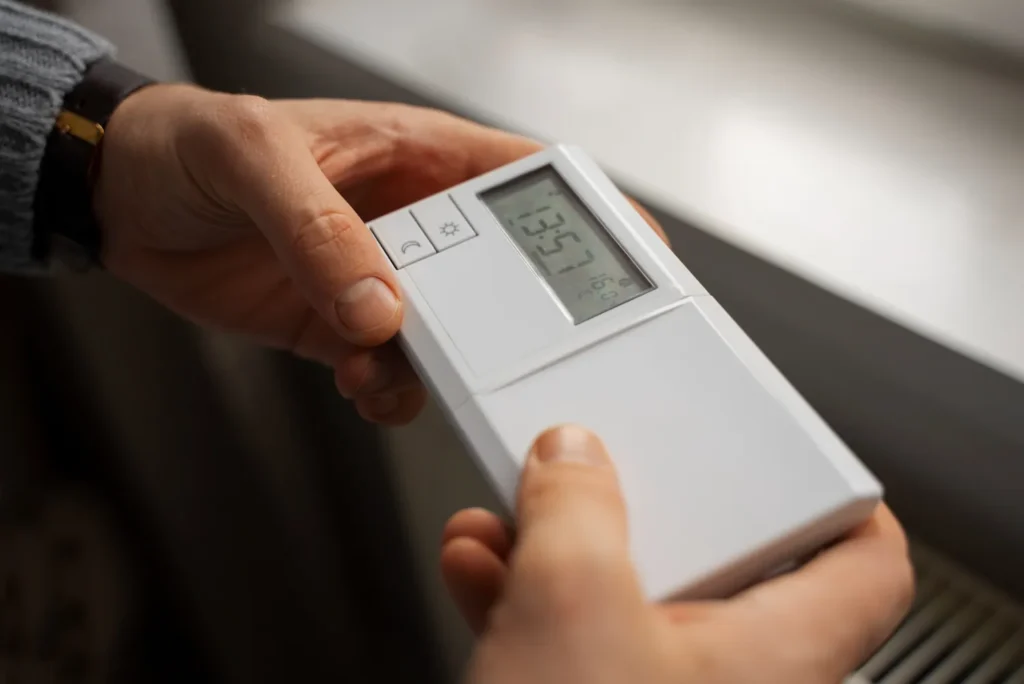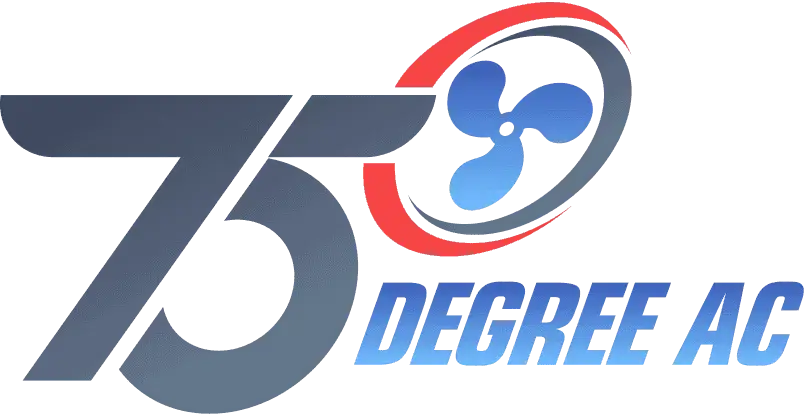A thermostat acts as the central nervous system of your HVAC system, dictating comfort levels and managing energy consumption. But what happens when this crucial component malfunctions? Identifying the signs of a wrong or broken thermostat is essential to maintaining an efficient HVAC system. Here, we’ll explore the most common lousy bad thermostat symptoms and provide expert solutions from 75 Degree AC, your trusted partner in keeping your home comfortable all year round.
5+ Signs of a Bad Thermostat

Identifying the signs of a malfunctioning thermostat is crucial for maintaining your home’s comfort and efficiency. A faulty bad thermostat symptoms can lead to various issues within your HVAC system, causing discomfort and increased energy bills. Here are several signs that your thermostat may be failing:
The AC or Furnace Won’t Turn On
One of the most definitive bad thermostat symptoms is when your AC or furnace fails to activate. If you adjust your thermostat and hear no sound of life from your HVAC system, the thermostat may not communicate effectively with the system. This could be due to various issues, such as dead batteries, incorrect settings, or a broken internal mechanism. Before calling for a professional service like 75 Degree AC, ensure that the thermostat is set to the correct mode (heating or cooling) and that the set temperature is appropriate for activation.
The HVAC System Won’t Turn Off
Another tell-tale sign of a thermostat problem is when your HVAC system runs continuously and doesn’t turn off. This can lead to excessive wear and tear on the system and unnaturally high energy costs. Often, this issue arises from a thermostat that fails to read the correct room temperature or is stuck in the call-for-heat or call-for-cool position. This may result from a calibration issue, where the thermostat is not correctly measuring the room’s ambient temperature. In such cases, the thermostat continuously signals the HVAC system to keep running because it falsely perceives that the desired temperature has not been reached.
Thermostat Doesn’t Respond
When adjustments to the thermostat’s settings (like changing the temperature or switching between heating and cooling) produce no change in your HVAC system’s behavior, it is likely that your thermostat is not responding. This lack of response can be due to various reasons, such as electrical failures, a disconnected wire, or a malfunctioning sensor. A non-responsive thermostat is problematic because it does not activate the HVAC system as needed, leading to inadequate heating or cooling. To troubleshoot, check if the display works and ensure the thermostat is set to the correct settings. If the screen is blank, you may need to replace the batteries. If these steps don’t solve the issue, it might be time to consult with HVAC professionals from 75 Degree AC, who can provide a more thorough diagnosis and solution.
The HVAC System Short-Cycles
Short-cycling is a common issue where your HVAC system turns on and off more frequently than usual, failing to complete an entire heating or cooling cycle. This erratic behavior can significantly stress your system, leading to premature wear and higher energy costs. Typically, short cycling can be traced back to a bad thermostat symptoms. Suppose the thermostat is improperly calibrated or installed in a spot with fluctuating temperatures (near windows, doors, or direct sunlight). In that case, it may misinterpret the indoor climate, causing the system to cycle incorrectly. To diagnose this, observe the cycle frequency and check the installation location of your thermostat. Adjusting the location or recalibrating the thermostat can often resolve this issue. If the problem persists, it may indicate a deeper issue within the HVAC system, requiring professional assessment from technicians like those at 75 Degree AC.
The thermostat Doesn’t Match the Room Temperature.
A thermostat that displays a temperature different from the actual room temperature can cause your HVAC system to underperform or overwork, resulting in discomfort and wasted energy. This discrepancy might be due to poor thermostat placement, where heat sources or drafts affect its sensors, or a sign of a faulty sensor within the thermostat. Ensuring your thermostat is placed away from direct sunlight, drafts, doorways, windows, and kitchen heat sources can help improve its accuracy. If repositioning the thermostat doesn’t resolve the issue, recalibration might be necessary. For digital thermostats, recalibration can be as simple as adjusting settings through the interface, whereas analog thermostats might require manual adjustments or replacement.
The Programmed Settings Reset Themselves
If your thermostat’s programmed settings reset themselves without apparent reason, it strongly indicates an internal fault. Power surges, outdated firmware, or battery problems could cause this. Such resets can disrupt your heating and cooling schedule, leading to inefficiencies and discomfort. First, try replacing the thermostat’s batteries to ensure a stable power supply. If the issue continues, check for updates on digital thermostat models or consider resetting it to factory settings. If these steps do not resolve the problem, the thermostat may need to be replaced. Consulting with HVAC professionals like those at 75 Degree AC can provide solutions that ensure your thermostat maintains its settings and operates efficiently.
How To Fix a Broken Thermostat
Dealing with a malfunctioning thermostat can be frustrating, but many common issues can be resolved with simple fixes. Here are some practical steps to troubleshoot and repair your thermostat, ensuring it operates efficiently and effectively controls your HVAC system.
Check and Adjust the Settings
The first step in troubleshooting a bad thermostat symptoms issue is to check and adjust its settings. Ensure that the thermostat is set to the correct mode—either “heat” or “cool”—and that the temperature settings are appropriate for the current weather conditions. It’s also essential to verify that the fan is set to “auto” rather than “on,” which only circulates air without heating or cooling. Misconfigured settings can often mimic symptoms of a faulty thermostat. Adjusting these settings can resolve what appears to be a thermostat issue without further intervention.
Replace the Batteries
Many modern thermostats use batteries to power their electronic controls. Replacing the batteries may resolve the issue if your thermostat’s display is non-responsive or dim. This is one of the most straightforward fixes that can restore functionality to a thermostat. It’s a good practice to replace the batteries annually to prevent thermostat failures due to power issues.
Clean the Thermostat
Over time, dust and debris can accumulate inside the thermostat, potentially interfering with its mechanical and electrical components. To clean your thermostat, first turn off the power to avoid any electrical hazards. Then, remove the cover and use a soft brush or compressed air to gently clean away any accumulation inside. Be careful not to damage any wiring or components while cleaning. This maintenance can help ensure accurate temperature readings and reliable operation.
Check the Wire Connections
Loose or corroded wire connections can cause a thermostat to malfunction. After turning off the thermostat’s power to ensure safety, remove the cover and inspect the wires. Make sure all connections are tight and secure. If you notice any corrosion, gently clean the contacts or replace them. Ensuring solid wire connections can resolve issues of intermittent or failed responses from the HVAC system.
Reset the Circuit Breaker
If your thermostat and HVAC system are completely unresponsive, the issue may be with your home’s electrical system rather than the thermostat itself. Check your home’s circuit breaker or fuse box; a tripped breaker or blown fuse could be cutting power to your system. Resetting the breaker or replacing the fuse might restore power and functionality to the thermostat and HVAC system.
Following these troubleshooting steps, you can address common bad thermostat symptoms issues and avoid needing professional repairs. However, if these steps do not resolve the problem or you are uncomfortable performing them yourself, it’s wise to call professionals like those at 75 Degrees AC. With expertise in HVAC systems, they can comprehensively assess and repair any complex issues with your thermostat or heating and cooling system.
Also Read >> Understanding AC Short Cycling – Causes and Quick Fixes
FAQs About Bad Thermostat Symptoms
When it comes to maintaining an efficient and functional HVAC system, understanding the role of the thermostat is crucial. Here, we address some frequently asked questions about bad thermostat symptoms issues to help you diagnose and solve common problems before they require professional intervention.
What are the symptoms of a bad AC thermostat?
The bad thermostat symptoms can include the HVAC system failing to turn on or off, unresponsive thermostat controls, frequent and erratic cycling of the system (short-cycling), a mismatch between the thermostat display and actual room temperatures, and settings that reset themselves unexpectedly. These symptoms can lead to inefficiencies in heating and cooling, increased energy usage, and discomfort in your home environment.
Can a thermostat prevent your AC from working?
Yes, a malfunctioning thermostat can prevent your air conditioning system from working. If the thermostat fails to send the correct signals to the AC unit, the system may not turn on or operate efficiently. Common issues include dead batteries, misaligned settings, or internal faults within the thermostat.
What happens when your AC thermostat goes out?
When your AC thermostat goes out, it typically fails to communicate with your air conditioning system, which can result in the system not turning on or not responding to any changes you try to make via the thermostat. This lack of communication can cause your home to remain too warm or too cool, leading to discomfort and potential safety issues in extreme temperatures.
How can you tell if your air conditioner is broken or the thermostat is bad?
To determine whether the issue lies with the air conditioner or the thermostat, check the thermostat for apparent signs of malfunction, such as a blank screen, incorrect readings, or unresponsive controls. If adjusting the thermostat settings or replacing the batteries does not resolve the issue, the problem might be with the air conditioner. In such cases, signs of an AC issue can include unusual noises, leaks around the unit, and continuous operation without effectively cooling or heating the space.
How do you tell if your thermostat is stuck closed?
A thermostat that is stuck closed continuously sends a signal to the HVAC system to keep running, which can lead to the system operating nonstop. This condition often results in excessive cooling or heating and significantly increased energy bills. If adjusting the thermostat’s settings does not stop the system from running, it may be stuck closed, requiring recalibration or replacement.
How do you know if you need a new thermostat?
You might need a new thermostat if it frequently malfunctions, fails to control your HVAC system efficiently, or exhibits continuous issues such as unresponsive controls, incorrect temperature readings, or failure to maintain set programs. Additionally, if your thermostat is old or uses outdated technology, upgrading to a newer, programmable model could enhance your system’s efficiency and provide better temperature management.
